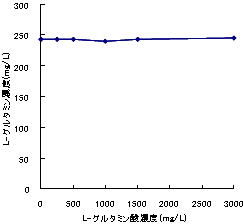L-glutamine assay kit
This product is an L-glutamine measurement kit using L-glutamate oxidase1). Even in samples containing both L-glutamic acid and L-glutamine, only L-glutamine can be specifically quantified (see the principle of measurement). In addition, L-glutamine can be quantified by a simpler method than that using L-glutamate dehydrogenase (see the measuring method). All necessary reagents are included with ready-to-use R1 and 2 enzyme reagents (see the product contents).
The product that allows simple measurement of glutamine is useful in controlling L-glutamine concentrations in media to produce antibodies and recombinant proteins from cultured cells, and quantifying L-glutamine in various foods. In addition, it can also be applied to the quantification of L-glutamine in various samples in amino acid metabolism research in the fields of biochemistry and medicine.
After the addition of the R1 enzyme reagent, L-glutamic acid in a sample is oxidized by L-glutamate oxidase, generating hydrogen peroxide. Since the hydrogen peroxide is decomposed by catalase, L-glutamic acid preliminarily contained in the sample is removed. Subsequently, after the addition of the R2 enzyme reagent, L-glutamine in the sample is decomposed to L-glutamic acid by glutaminase. The L-glutamic acid is oxidized by L-glutamate oxidase, generating hydrogen peroxide. The generated hydrogen peroxide exhibits a purple color produced by the reaction of a chromogenic substrate and peroxidase. The L-glutamine concentration in a sample is determined using the absorbance (555 nm) of the purple color. Immediately after the addition of the R2 enzyme reagent, the catalase is immediately deactivated by sodium azide.
| ○ Code # | 80116 | ||
| ○ Product name | L-glutamine assay kit | ||
| ○ Components | R1 enzyme reagent | 30 mL | 1 bottle |
| R2 enzyme reagent | 30 mL | 1 bottle | |
| Glutamine standard (250 mg/L, Lyophilized) | – | 1 vial | |
| *A total of 66 measurements can be conducted according to the attached document (including a standard solution, blank, and control). | |||
| ○ Storage | Store in the dark at 2-8°C | ||
| ○ Shelf life | 25 months after manufacture | ||
| ○ Suggested retail price | ¥ 160,000 | ||
Dissolve a glutamic acid standard solution (hereinafter, standard solution) in 0.5 mL of purified water. Prepare a control to examine the effects on measurement according to sample conditions.
| (1) | Dispense 10 μL each of sample, standard solution, and purified water into each test tube. |
| (2) | Dispense 450 μL of the R1 enzyme reagent into each tube, followed by mixing. |
| (3) | Allow the tube to stand for 20 minutes at 20-30℃. |
| (4) | Dispense 450 μL of the R2 reagent into each tube, followed by mixing. |
| (5) | Allow the tube to stand at 20-30℃ for 20 minutes. Measure absorbance at 555 nm using purified water as a control. |
| (6) | Calculate L-glutamine content in the sample according to the following formula using the absorbance of sample (A), standard solution (S), and purified water (R). L-glutamine (mg/L) = (A-R) ÷ (S-R) x 250 x dilution rate (for a diluted sample) |
| [Example of a calibration curve for L-glutamine]
L-glutamine can be measured in the range of 10-1,500 mg/L. |
[Effects of L-glutamic acid in samples]
In samples containing about 250 mg/L L-glutamine, L-glutamic acid has no effects on measurement even if at concentrations of 3,000 mg/L. |
|
In this product, a color reaction is inhibited by L-ascorbic acid in a sample if it is present above a certain level. For example, if the concentration of L-ascorbic acid is 25 mg/mL in 250 mg/L L-glutamine, the absorbance is reduced by about 10%, compared to its absence. Therefore, for the measurement of L-glutamine in such samples, appropriate pretreatment is needed. As a method to prevent the inhibitory effects of L-ascorbic acid on coloring, enzymatic treatment with ascorbate oxidase is employed (see the example below).
Ascorbate oxidase is not included in the product, and is unavailable from our company. Please purchase a commercially available product.
[Example of pretreatment with ascorbate oxidase]
An example of pretreatment using a 250 mg/mL L-glutamine solution is shown below. The concentration of ascorbate oxidase is adjusted to 5 U/mL in PBS.
(1) Add 10 mL of ascorbate oxidase solution to 10 mL of sample.
(2) Allow the sample to stand at room temperature for 10 minutes.
(3) Measure the treated solution as a sample (the original sample is diluted twofold).
After this treatment, there is no effect on L-glutamine measurement even if at 1,000 mg/L of L-ascorbic acid.
However, during sample pretreatment, a sample containing an appropriate amount of L-glutamine should be simultaneously measured to check the recovery rate.
1) Arima J et al. (2003). J Biochem 134. 805-812.


